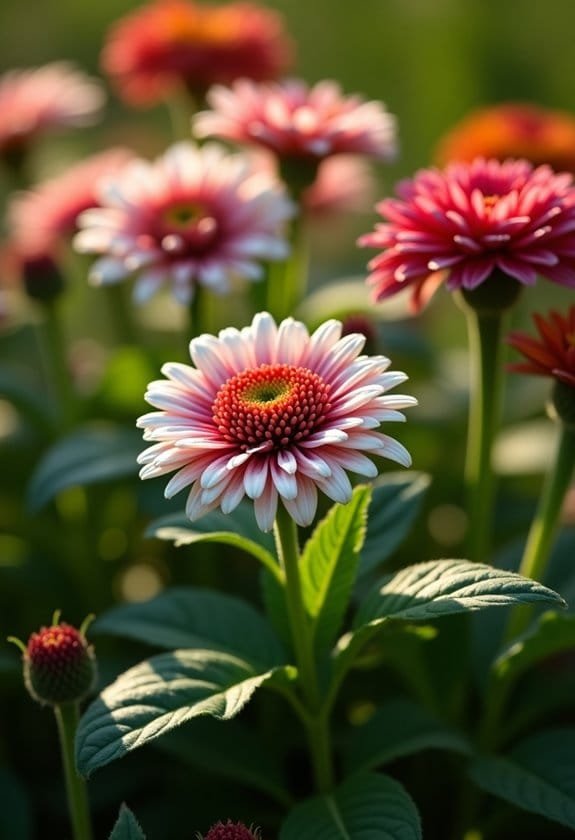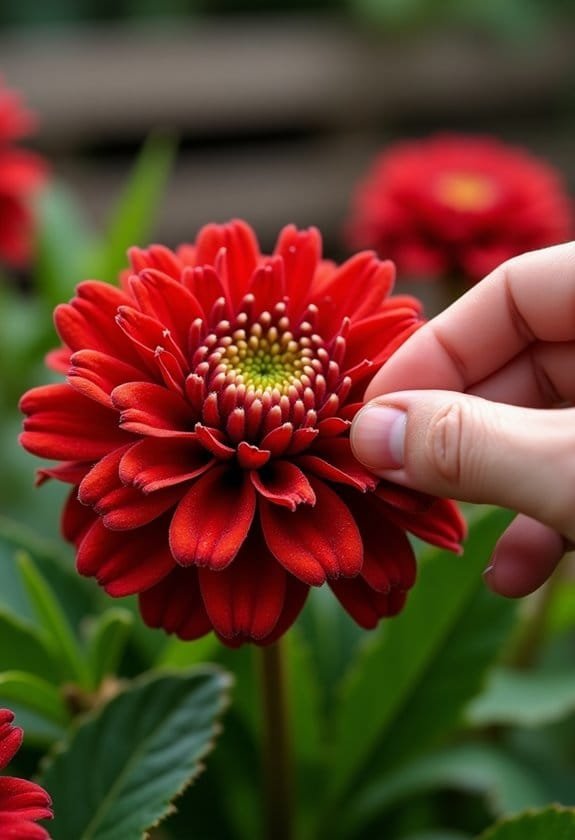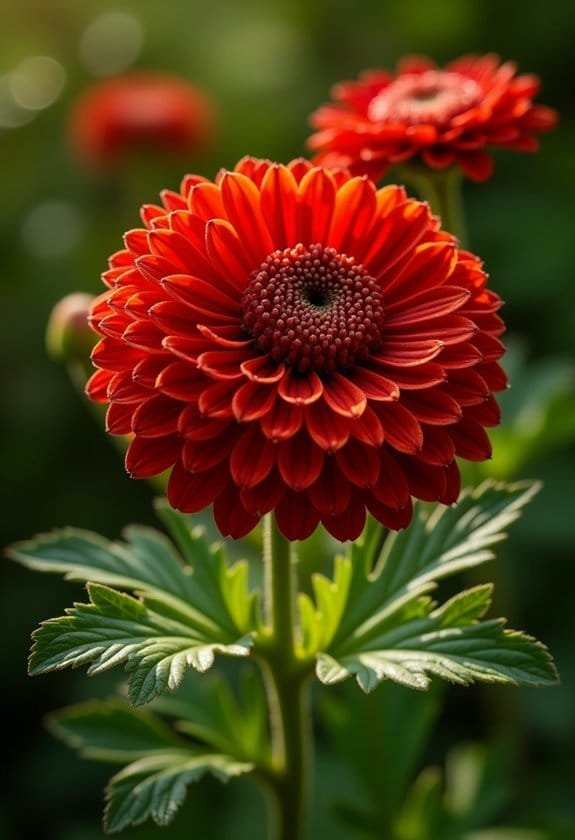Tanacetum coccineum, commonly called Pyrethrum or Painted Daisy, is an intriguing perennial reaching heights of 1.5 to 3 feet, boasting large, vibrant flowers that bloom from June to July. This plant thrives in full sun to partial shade, preferring well-drained soils and a pH between 6.0 and 7.0. Not only does it enhance garden aesthetics, but it also attracts important pollinators, such as bees and butterflies, contributing to local biodiversity. Furthermore, Pyrethrum produces pyrethrins, which serve as natural insect repellents. Consequently, its cultivation offers both beauty and ecological advantages, revealing even more fascinating aspects of this remarkable plant.
Main Points
- Tanacetum coccineum, or Painted Daisy, features vibrant flowers in pink, red, purple, and white, blooming from June to July.
- This bushy perennial thrives in USDA zones 3 to 7, preferring full sun and well-drained sandy or loamy soil.
- It attracts pollinators like bees and butterflies, enhancing biodiversity while producing natural insecticides known as pyrethrins.
- Regular maintenance, including deadheading and pruning, promotes bushier growth and continuous blooming throughout the season.
- Common pests include aphids and spider mites, requiring vigilant monitoring and organic treatment options for effective pest management.
Introduction

Tanacetum coccineum, often referred to as Pyrethrum or Painted Daisy, captivates with its stunning, multi-hued blooms and aromatic foliage.
This bushy perennial thrives in gardens, reaching heights of up to 3 feet and attracting both pollinators and curious gardeners alike.
Recognized for its insect-repelling pyrethrins, Pyrethrum serves not only as an ornamental plant but also as a valuable ally in sustainable pest management.
Common Name
One of the most striking features of Pyrethrum, commonly known as Painted Daisy, is its vibrant display of colors that can transform any garden. The botanical name, Tanacetum coccineum, aptly describes a plant adorned with dahlia-like daisies, showcasing an impressive palette that includes hues of pink, red, purple, and white, all accented by bright yellow centers.
These enchanting flowers typically measure around 3 inches in diameter, making them a prominent feature during their blooming period from June to July. With its bushy and upright stature, the Painted Daisy has carved a niche as a favored choice for flower beds and borders, offering not just beauty but also substance to outdoor spaces.
Beyond aesthetic appeal, Pyrethrum is celebrated for its natural insect-repelling properties derived from its blooms. This functional aspect highlights its dual role in gardens: a visual delight that contributes to pest management.
Scientific Name
Known for its robust characteristics, the scientific name of the Painted Daisy is Tanacetum coccineum, which situates it within the Asteraceae family, renowned for its vast array of flowering plants. This herbaceous perennial typically reaches heights between 1.5 to 3 feet, expanding to widths of 1.5 to 2 feet, making it a striking addition to gardens and landscapes.
Native to Eastern Europe, Central Asia, and Iran, Tanacetum coccineum flourishes in USDA hardiness zones 3 to 7, benefiting from well-drained soils and ample sunlight. The plant is especially admired for its large, daisy-like flowers that bloom vibrantly in shades of red, pink, purple, and white, each adorned with a characteristic yellow center.
These stunning flowers usually appear between June and July, painting gardens in lively colors.
Importantly, Tanacetum coccineum is valued not only for its aesthetic appeal but also for its role in pest management. It produces pyrethrins, potent natural insecticides that effectively deter harmful pests, enhancing its utility in organic gardening. Additionally, Charlock's competitive nature can influence the growth of neighboring plants in agricultural settings.
Consequently, coccineum isn't merely a beautiful flower but a multifunctional plant that enriches both gardens and ecological health.
Overview
Admired for its vibrant blooms and pest-fighting properties, Pyrethrum, or Painted Daisy, stands out as a versatile and attractive addition to gardens. This bushy perennial, scientifically known as Tanacetum coccineum, typically reaches heights of 1.5 to 2.5 feet, spreading 1.5 to 2 feet wide.
From June to July, it showcases an array of showy magenta pink blooms, each approximately 3 inches in diameter, adorned with prominent yellow centers that beckon butterflies and other essential pollinators.
The aromatic, medium green, fern-like leaves enhance its ornamental appeal, creating a lush backdrop for its striking flowers. Beyond aesthetics, Pyrethrum offers practical benefits; it produces pyrethrins, a natural insecticide beneficial for effective pest management in gardens.
Thriving in USDA hardiness zones 3 to 7, this plant prefers full sun to partial shade and well-drained, moist sandy or loamy soils. Best propagated through seeds, cuttings, or divisions, Pyrethrum not only enriches garden landscapes but also contributes to sustainable pest control, reflecting the harmony inherent in nature's design.
Its ability to enhance ecological balance while enchanting viewers with its beauty exemplifies the essential role of such plants in contemporary gardening.
Key Features
Tanacetum coccineum, or Pyrethrum, showcases remarkable features that make it a standout in any garden. Typically reaching heights of 1.5 to 3 feet and displaying large, vivid blooms in shades of pink, red, and purple, this perennial presents an inviting aesthetic throughout its flowering season from early to mid-summer.
With its bushy growth habit and aromatic, fern-like foliage, this plant not only enhances landscapes but also attracts butterflies, while its natural pest-repelling abilities further enhance its appeal for gardeners seeking effective, eco-friendly solutions.
Growth Size
Pyrethrum showcases an impressive growth size, typically forming upright bushy clumps that reach heights of 1.5 to 2.5 feet (18-30 inches) and spread out to 2 feet wide. This robust perennial is characterized by aromatic, medium-green, fern-like leaves that create a lush garden backdrop. The foliage features a layering effect, with upper leaves shorter than the lower ones, contributing to its textured appearance.
In early to mid-summer, Pyrethrum enchants with its large, daisy-like flowers that can grow to approximately 3 inches in diameter. Among the various colorations, one can find delicate pale pink blooms that stand out elegantly against the verdant foliage. These bright, cheerful flowers not only enhance the aesthetic of any garden space but also play a crucial role in supporting local ecosystem health by attracting beneficial insects.
Thriving in full sun to partial shade with a preference for well-drained, sandy to loamy soils, Pyrethrum demonstrates adaptability across USDA hardiness zones 3 to 7.
Appearance
With its bushy clumps and vibrant blooms, this perennial creates a striking visual presence in any garden.
Tanacetum coccineum, commonly known as Painted Daisy or Pyrethrum, showcases large daisy-like flowers that dazzle the eye with shades of pink, red, purple, or white, each adorned with distinct yellow centers. These blooms typically measure around 3 inches in diameter, making them a focal point in floral displays.
The plant's medium green, soft, fern-like leaves, which are aromatic, enhance its allure. The upper leaves are shorter than the lower ones and are arranged alternately along the wiry stems, contributing to the plant's elegance. Standing upright, the bushy clumps generally reach heights of 1.5 to 3 feet and spread 1.5 to 2 feet wide, creating a lush backdrop for the blooms during their peak.
Additionally, the wiry flower stems elevate the vibrant petals above the foliage, rendering Tanacetum coccineum an exceptional choice for cut flower arrangements.
With blooms that persist and provide both color and texture, this perennial captivates gardeners and onlookers alike, adding a dynamic element to the landscape.
Flowering Season
During the flowering season, Pyrethrum dazzles gardens with its vibrant colors from June to July. These mesmerizing blooms feature a stunning array of hues, ranging from bright pink and deep red to soft purple and pristine white, each with a striking yellow center. Measuring approximately 3 inches in diameter, the daisy-like flowers capture attention as they unfold, sometimes transforming into blooms turning pale pink as they mature.
The flowering period extends throughout early and mid-summer, allowing gardeners to enjoy a continuous display of beauty. To prolong this enchanting phase, it's advisable to gently pinch back new growth when it reaches 6 to 8 inches in height; this practice encourages bushier plants loaded with blooms. Additionally, engaging in the practice of deadheading spent flowers can enhance the aesthetic appeal of the garden while promoting a second wave of blossoms.
In the tapestry of summer gardens, Pyrethrum plays a significant role, offering both visual delight and valuable pollinator support. The combination of their vibrant colors and effortless care makes them a beloved choice among horticulturists seeking to enhance their floral displays, transforming any outdoor space into a vibrant sanctuary.
Growing Requirements

Tanacetum coccineum, or Pyrethrum, flourishes under a full sun to partial shade regime, requiring well-drained sandy to loamy soil that retains moderate moisture.
This perennial plant, with its impressive height of 1.5 to 3 feet, not only beautifies borders and flower beds but also thrives across hardiness zones 3 through 7, adapting to a variety of climates.
Understanding its growing requirements—light, soil quality, moisture levels, and temperature—becomes essential for gardeners aiming to cultivate vibrant, healthy blooms.
Light
For the best growth, Tanacetum coccineum, commonly known as Painted Daisy, thrives in conditions where it receives at least 6 hours of direct sunlight each day. This perennial plant flourishes in full sun, which energizes its vibrant blooms and promotes robust foliage development.
While it can tolerate some partial shade, inadequate sunlight may hinder its flowering potential, resulting in a less impressive display. In its ideal habitat, the Painted Daisy exhibits a lush, bushy growth pattern, displaying rich, colorful flowers that entice pollinators.
Providing a sunny location encourages the plant to establish deeper root systems, which enhance its overall health and resilience against stresses. Especially, those cultivating Painted Daisies should consider their climate; this species is hardy in USDA zones 3 through 7, meaning it can adapt well to varied conditions.
Regular care, including deadheading spent blooms, will extend the blooming period, ensuring a stunning visual impact throughout early and mid-summer. To sum up, ensuring Tanacetum coccineum receives adequate full sun will greatly enhance its growth, beauty, and longevity in any garden landscape.
Soil
The health and essence of Painted Daisies hinge on suitable soil conditions. Tanacetum coccineum flourishes in well-drained soils, ideally composed of sandy to loamy textures. These soil types retain moderate moisture, ensuring the roots receive adequate hydration without becoming overwhelmed by excess water.
This vibrant plant demands average to nutrient-rich soils, which foster vigorous growth and contribute to those striking, pure white flowers that captivate any garden.
An ideal soil pH, ranging from 6.0 to 7.0, plays an essential role in the plant's nutrient uptake. When soil pH resides within this range, nutrients become available for absorption, enhancing the plant's overall robustness. Conversely, heavy, wet soils can lead to root rot, a condition detrimental to the health of Painted Daisies.
To promote optimal growing conditions, regular mulching assists in moisture retention while simultaneously suppressing weeds that compete for resources.
Water
Proper watering is crucial for nurturing Painted Daisies, as they thrive best when their roots have consistent access to moisture without being waterlogged. Tanacetum coccineum prefers well-drained soils that maintain moderate moisture levels to support ideal growth. While established plants tolerate drought, regular watering during dry spells, particularly in summer, greatly enhances their vitality.
To avoid overwatering, gardeners should guarantee that the soil remains moist but not saturated, as heavy, wet soils can lead to detrimental root rot and other complications. Watering should focus on the base of each plant, concentrating moisture directly on the root zone, thereby promoting healthy growth.
Additionally, applying mulch around the plants proves beneficial; it retains soil moisture and suppresses weed growth, creating a perfect environment for the roots to flourish. This practice not only conserves water but also reduces competition for precious nutrients.
Regularly checking soil moisture levels with a finger test or moisture meter helps gardeners gauge when to water, guaranteeing that Painted Daisies receive just the right amount. By providing the right balance of moisture, gardeners can cultivate stunning displays of vibrant blooms, enhancing their garden's allure throughout the season.
Temperature
When growing Tanacetum coccineum, maintaining the ideal temperature is crucial for successful germination and overall plant health. These vibrant plants thrive best in temperatures ranging from 60°F to 70°F during their germination phase. This specific temperature range not only promotes effective sprouting but also guarantees that the emerging seedlings develop strong roots, essential for their growth.
Moreover, winter chilling conditions can enhance spring germination, effectively mimicking the natural seasonal changes that pyrethrum experiences in the wild. Established plants exhibit remarkable drought resistance; however, they flourish most when subjected to consistently warm temperatures throughout the growing season.
Floricultural practices, such as pinching back new growth when plants reach 6 to 8 inches in height, further stimulate growth during these ideal temperatures.
It's important to remember that pyrethrum prefers locations that provide full sun to partial shade. Such placements allow the plants to bask in warm temperatures while absorbing ample sunlight, thereby maximizing their growth potential.
Pollinator Criteria
Tanacetum coccineum, or Pyrethrum, serves as a vibrant haven for an array of pollinators, particularly butterflies and bees, which flock to its colorful flowers. These striking blooms, rich in nectar and pollen, facilitate cross-pollination, a process essential for the genetic diversification of plants. Additionally, the extended flowering period supports diverse pollinator interactions, similar to that of Bugloss's flowering period. Moreover, like wild strawberries, wild strawberries' flowering period plays a crucial role in attracting and sustaining pollinator populations throughout the growing season.
Attracted Pollinators
As summer unfolds, vibrant Tanacetum coccineum flowers attract a variety of pollinators, such as bees and butterflies, which play an essential role in maintaining garden biodiversity. These daisy-like blooms, emerging from June to July, serve as a rich nectar source during the active summer months, drawing in numerous beneficial insects.
The bushy growth habit and colorful flowers of Tanacetum coccineum create not only a visually striking display but also an inviting habitat for pollinators. The aromatic foliage may additionally entice pollinators while acting as a deterrent for some common garden pests, hence fostering a balanced ecosystem.
Gardeners who opt to plant these flowers in clusters effectively enhance local pollinator populations, providing numerous landing and feeding sites that reinforce biodiversity.
With their ability to thrive in diverse garden settings, Tanacetum coccineum flowers demonstrate their value for creating a pollinator-friendly environment. By incorporating these plants into pollinator gardens, gardeners contribute to the essential work of pollinators, establishing healthier ecosystems that support both flora and fauna.
In this way, Tanacetum coccineum becomes more than just an attractive plant; it becomes a key ally in sustaining our natural world.
Pollination Method
The vibrant blooms of Pyrethrum play an essential role in attracting pollinators, utilizing their unique flower structure to enhance pollination efficiency. These enthralling pink, daisy-like flowers feature bright petal rays that encircle a striking yellow disc center, effectively guiding pollinators toward the reproductive parts. This design not only facilitates easier access to nectar but also increases the likelihood of successful pollen transfer.
Flowering from June to July, Pyrethrum coincides with peak activity for many important pollinators, such as butterflies and bees, enriching the pollination process. Moreover, the plant's aromatic foliage emits scents that lure beneficial insects, enhancing both pollination rates and pest management within the garden ecosystem.
Planting Pyrethrum in groups amplifies visual and aromatic cues, creating a more significant signal that draws in numerous pollinators seeking sustenance and contributing to a harmonious garden environment.
The synergy between the plant's structure and the behavior of pollinators epitomizes nature's intricate design, reflecting a delicate balance that sustains entire ecosystems. Through thoughtful cultivation, gardeners can foster these interactions, ensuring robust pollinator populations essential for biodiversity and food production.
Care & Maintenance

In caring for Tanacetum coccineum, one must prioritize careful ongoing maintenance to guarantee vibrant growth and stunning blooms.
Regularly pruning stems post-flowering not only rejuvenates the plant but also enhances its overall vigor, while consistent watering during dry spells safeguards against root rot.
Choosing compatible companions can further enrich the garden ecosystem, promoting harmonious growth and resilience against common pests like aphids and spider mites.
Planting Tips
Proper care and maintenance of Tanacetum coccineum will guarantee these vibrant perennials flourish in your garden.
When planting, choose well-drained, sandy to loamy soils that receive full sun to partial shade, as these conditions are perfect for their growth. Remember to water regularly during dry spells, particularly in summer, while avoiding overly saturated soils that may cause root rot.
An essential planting tip involves pinching back new growth when it reaches 6 to 8 inches to encourage bushiness and enhance flowering. The blooming period extends from June to July, offering a stunning display of color.
After flowering, regular deadheading promotes renewed foliage and boosts new blooms, ensuring a longer blooming season.
To foster robust development and vibrant cut flowers, fertilize monthly with a balanced fertilizer throughout the growing season.
Mulching around the base serves additional purposes; it retains moisture and suppresses the growth of weeds, creating an ideal environment for these dynamic plants.
Ongoing Care
Ongoing care for Tanacetum coccineum is essential to keep these perennials thriving year after year.
Regularly cutting back stems after flowering encourages new blooms and rejuvenates foliage for the next growing season, offering a vibrant display. This practice is similar to the maintenance of Comfrey's growth which benefits from regular monitoring and pruning.
During dry spells, particularly in summer, one must water the plants moderately to maintain adequate moisture levels in the soil, preventing stress.
Fertilizing the plants monthly with a balanced fertilizer allows for peak growth and flowering.
This nourishment supports the plant's developmental needs, fortifying it against potential stresses.
Additionally, monitoring for pests such as aphids, spider mites, and leaf miners guarantees plant health; organic treatments can be applied if infestations are detected, promoting a vibrant ecosystem in the garden.
Moreover, mulching around the plants not only helps retain soil moisture but also suppresses weed growth, creating a healthier environment.
This layer acts as a protective blanket, maintaining temperature and moisture levels. Birds Foot Trefoil is beneficial in enhancing soil quality, making it an excellent companion plant for Tanacetum coccineum.
Suggested Companions
Planting Tanacetum coccineum (Pyrethrum) alongside compatible companions enhances both beauty and functionality in the garden. Ideal companions such as Salvia, Echinacea, and Agastache thrive in cottage gardens, offering a vibrant palette that attracts important pollinators while simultaneously aiding pest control.
These flowering plants can coexist effectively; however, it's imperative to space them adequately to accommodate their unique growth habits. This intentional spacing allows each plant to receive ample sunlight and nutrients without succumbing to overcrowding. Additionally, white clover's ability to fix nitrogen enhances soil fertility, benefiting neighboring plants.
Regular monitoring and maintenance are critical for overall health. Pruning and dividing companion plants not only promote vigorous growth but also reduce the risk of aphid and spider mite infestations.
It's necessary to provide well-drained, nutrient-rich soil, as favorable conditions foster a flourishing garden ecosystem, benefiting both the Pyrethrum and its companions. Additionally, incorporating Salad Burnet's exceptional drought tolerance can improve the resilience of the garden during dry spells.
Implementing organic mulch around all plants plays a significant role as well, aiding moisture retention and suppressing weeds that compete for resources.
The harmonious integration of Tanacetum coccineum with these companion plants creates a bountiful environment, enhancing the aesthetic appeal and ecological balance of any cottage garden.
Common Issues
As Tanacetum coccineum, or pyrethrum, flourishes in gardens, it often faces challenges from pests and diseases that can hinder its growth.
Common culprits like aphids and spider mites threaten not only the vibrancy of its blooms but also the overall health of the plant, necessitating vigilant monitoring and effective management strategies.
Additionally, while generally resilient, these plants can succumb to issues such as root rot if planted in poorly draining soils, underscoring the importance of proper site conditions for ideal development.
Pests/Diseases
Pests can quickly become a significant concern for gardeners cultivating Tanacetum coccineum, commonly known as pyrethrum. Among the most common pests are aphids, spider mites, and chrysanthemum nematodes, each capable of weakening plants and diminishing blooms.
Aphids, small and sap-sucking, can proliferate rapidly and transmit harmful viruses, making their presence a serious threat. Spider mites, on the other hand, often leave behind silken webs, indicating a potential infestation that can cause discolored foliage.
Leaf miners contribute further challenges as they tunnel through leaves, creating trails that detract from the plant's aesthetics. While Tanacetum coccineum is generally resilient, routine monitoring is essential for early detection of these pests.
The potential implications of unchecked infestations can lead to significant degradation in plant health and vibrancy.
Fortunately, treatment options abound, including the application of insecticidal soap or organic solutions, which effectively combat aphids and spider mites.
Solutions
Effective solutions exist for common issues encountered with Tanacetum coccineum, ensuring these plants thrive in garden settings. To foster robust growth, gardeners should monitor for pests such as aphids, leaf miners, and spider mites, which can adversely affect blooming and overall health. If handling the plant generates sensitivity due to its sap, wearing gloves offers necessary protection.
Moreover, pinching back new growth when it reaches 6-8 inches not only cultivates a bushier appearance but also enhances the potential for vibrant blooms, adding pale yet stunning colors to the garden.
After flowering concludes, cutting back the stems rejuvenates the plant, promoting additional blooms in the fall.
Careful inspection for nematodes is also essential, as these microscopic pests can undermine the health of Pyrethrum plants.
Summary

Tanacetum coccineum, commonly known as Pyrethrum or Painted Daisy, is a striking perennial admired for its vibrant daisy-like blooms in various colors, including pink, red, and white. Flourishing mainly from June to July, this plant thrives in USDA hardiness zones 3-7, favoring well-drained, moist sandy to loamy soils, with a preference for full sun to partial shade.
Its striking colors enhance gardens, offering visual appeal that captivates butterflies while simultaneously being deer resistant—an ideal choice for diverse landscapes.
Beyond its aesthetic value, Tanacetum coccineum is notable for its aromatic, fern-like foliage and the production of pyrethrins, natural insecticides that support pest management. Maintenance is straightforward; gardeners often pinch back new growth to encourage flowering and cut back stems post-bloom for renewed vigor.
Propagation methods include seeds, cuttings, and divisions, allowing for the easy expansion of this delightful plant.
Various cultivars, such as "Brenda" with its magenta flowers and "Mont Blanc" featuring pristine white blooms, further enhance its versatility in flower beds, borders, and cut flower arrangements.


